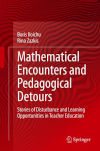- About MAA
- Membership
- MAA Publications
- Periodicals
- Blogs
- MAA Book Series
- MAA Press (an imprint of the AMS)
- MAA Notes
- MAA Reviews
- Mathematical Communication
- Information for Libraries
- Author Resources
- Advertise with MAA
- Meetings
- Competitions
- Programs
- Communities
- MAA Sections
- SIGMAA
- MAA Connect
- Students
- MAA Awards
- Awards Booklets
- Writing Awards
- Teaching Awards
- Service Awards
- Research Awards
- Lecture Awards
- Putnam Competition Individual and Team Winners
- D. E. Shaw Group AMC 8 Awards & Certificates
- Maryam Mirzakhani AMC 10 A Awards & Certificates
- Two Sigma AMC 10 B Awards & Certificates
- Jane Street AMC 12 A Awards & Certificates
- Akamai AMC 12 B Awards & Certificates
- High School Teachers
- News
You are here
Mathematical Encounters and Pedagogical Detours

Publisher:
Springer
Publication Date:
2021
Number of Pages:
222
Format:
Hardcover
Price:
149.99
ISBN:
978-3-030-58433-7
Category:
Monograph
[Reviewed by , on ]
Annie Selden
04/10/2022
The mathematical encounters, mentioned in the title, are “stimulating and often surprising engagements with mathematical concepts and problems” that the authors have met in their work as mathematics educators. The book also includes pedagogical detours, which are accounts of the authors’ experiences teaching mathematics. The idea for this book began as an extended conversation between authors, referred to as B. and R. in the text, that included sharing tasks they had designed for mathematics teacher education in which the idea of disturbance emerged. A disturbance might be a surprising remark offered in a lesson, a poor result on a test, something said by a colleague or something asserted in a journal or book. A prominent feature of this book is stories of disturbance and resulting learning opportunities. In Chapter 1 the authors elaborate on the theoretical framework of disturbance. The next five chapters, the bulk of the book, each begin with a structured dialogue between B. and R. and some fictional students, based on actual author discussions and data collected from their students. There follow mathematical encounters and pedagogical detours that range from arithmetic to geometry to calculus.
For example, Chapter 6, after a fictional conversation between B. and R., has some background from Lakatos’ (1976) book on Proofs and Refutations, as well as from Brown and Walter’s (1993) “What if not?” method of conjecturing and problem-posing based on an existing theorem. In the authors’ somewhat different “If not, what yes?” version, the teacher acknowledges the initial statement is wrong and asks students to correct it by providing a counterexample. The teacher then modifies the initial statement accordingly, and the students have the choice of trying to prove the modified statement or of providing a counterexample. This process repeats until a valid modification, preferably offered by the students, is suggested. As a rule, each new conjecture becomes more plausible, and the search for a counterexample becomes more challenging and the discussion becomes more sophisticated. The teachers’ role is to provide the initial plausible mathematical statement and to moderate the follow-up discussions. At the end of a successful discussion, the students usually have a feeling that they have worked on a mathematical result new to them and their teacher.
Chapter 6 provides an example from calculus. The initial statement to be considered is Every even function has a local strict extremum at x=0. This section goes through five plausible reformulations, ending with Every even function that is monotonic and not constant in a right-side neighborhood of x=0 has a local strict extremum at x=0. This statement is one most prospective or in-service teachers with appropriate mathematical background can prove. Although students often do not find this last formulation surprising or elegant, they usually appreciate the experience and feel that they have worked on “something real”. Then there is a follow-up lesson with three further reformulations, ending with If f(x) is an even function and f’(0) exists and is not zero, the f(x) has a strict local extremum at x=0. This is followed by a discussion of the difficulty of designing such mathematical encounters along with two examples of actual student teacher-generated initial statements that did not result in the hoped for modifications and discussions.
The authors distinguish their “If not, what yes?” method from the “What if not?” method of Brown and Walter. Both rely on systematic modifications of an initial statement, posing modified statements, and exploring their correctness. The later begins with a correct initial statement, whereas the authors’ method begins with an incorrect initial statement, which can be designed by starting with a correct statement and working backwards to a plausible, but incorrect, initial statement to be refuted by a counterexample. The design of such initial primitive statements requires teachers to think about possible student responses, and subsequent discussion of such tasks requires sensitivity to students’ ideas, flexibility, and self-confidence.
That said, the ideas presented in this book are not for beginning mathematics teachers, but are definitely worth considering by experienced mathematics teachers wanting to give their students an opportunity to experience (as closely as possible) real mathematical discovery. While the English of the book is excellent, the authors are not native speakers of English, so there may be some instances when the phrasing seems a bit stilted. In particular, the overarching question, “If not, what yes?” has an odd ring to it.
Annie Selden is Adjunct Professor of Mathematics at New Mexico State University and Professor Emerita of Mathematics from Tennessee Technological University. In 2002, she was recipient of the Association for Women in Mathematics 12th Annual Louise Hay Award for Contributions to Mathematics Education. In 2003, she was elected a Fellow of the American Association for the Advancement of Science. She remains active in mathematics education research.
See the publisher's website.
- Log in to post comments




